

Green for Oil Thinner by Sennelier. Green for Oil Gel Medium by Sennelier. Green For Oil non toxic additives. Solvent Free Brush Cleaning - M. Graham & Co. : M. Graham & Co. To avoid solvents while cleaning, use Walnut Oil in place of turpentine or odorless mineral spirit.
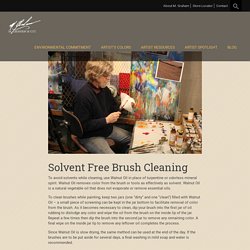
Walnut Oil removes color from the brush or tools as effectively as solvent. Walnut Oil is a natural vegetable oil that does not evaporate or remove essential oils. To clean brushes while painting, keep two jars (one “dirty” and one “clean”) filled with Walnut Oil – a small piece of screening can be kept in the jar bottom to facilitate removal of color from the brush. As it becomes necessary to clean, dip your brush into the first jar of oil rubbing to dislodge any color and wipe the oil from the brush on the inside lip of the jar. Repeat a few times then dip the brush into the second jar to remove any remaining color. Since Walnut Oil is slow drying, the same method can be used at the end of the day. Reminder: Immediately after use, dispose of contaminated waste in a sealed, water filled metal container. Solvent Free Oil Painting. Green For Oil non toxic additives. The Hunt for a Non-Toxic Solvent: Part III. Back in May of 2011 I wrote an article on Muddy Colors detailing my on-going search for an oil painting medium that would provide me with the following characteristics: 1.

Workability – That the paint itself allows for the smooth, buttery application consistent with that of traditional oil paints. 2. Archival-Longevity – That the final product will not suffer from any unreasonable, long-term degradation. (cracking, colors fading or darkening, wrinkling) 3. 4. It was easy to find a medium that would offer three but seemed impossible to find a suitable one that would offer all four. Solvent Free Brush Cleaning - M. Graham & Co. : M. Graham & Co. Cleaning Brushes Without Solvents. For oil painters who want to reduce the amount of solvent in their studio, we would like to share a solvent-free brush cleaning option that can be used during and after painting.
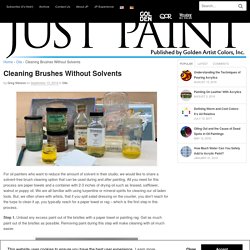
All you need for this process are paper towels and a container with 2-3 inches of drying oil such as linseed, safflower, walnut or poppy oil. We are all familiar with using turpentine or mineral spirits for cleaning our oil laden tools. But, we often share with artists, that if you spill salad dressing on the counter, you don’t reach for the turps to clean it up, you typically reach for a paper towel or rag – which is the first step in this process. Step 1. Yes, you can do solvent free oil painting! - The Art Store. There is nothing more natural and enduring than oil painting.
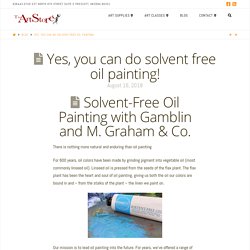
For 600 years, oil colors have been made by grinding pigment into vegetable oil (most commonly linseed oil). Linseed oil is pressed from the seeds of the flax plant. The flax plant has been the heart and soul of oil painting, giving us both the oil our colors are bound in and – from the stalks of the plant – the linen we paint on. Our mission is to lead oil painting into the future.
For years, we’ve offered a range of contemporary painting mediums around fast-drying, soy-based alkyd resin, which are formulated with the mildest solvent available: Gamsol. Though many painters have adopted Gamsol, we have worked with other painters who want to eliminate all solvent from their painting processes. Linseed and Safflower Oils.
Solvent Free Oil Paint Explained with Kyle Richardson. Tad Spurgeon : <?php echo formulas; ?> Methods and Materials of Painting - Sir Charles Eastlake Originally published in 1847, this is a great if complex book.
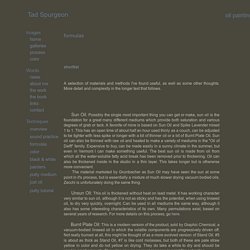
Eastlake was a painter, restorer, president of the Royal Academy, and first director of England's National Gallery: in the first page of his introduction he states that his aim is to help create methods of painting which are more durable based on the older systems. Full of anecdotes, technical innuendo, and well-chosen excerpts from the De Mayerne and other older recipe manuscripts, this book is crucial for anyone who wants to understand what became lost, why it became important, and how it began to be discovered once again: in the deepest sense, it is about the once and future truth of painting.
Medieval and Renaissance Treatises on the Art of Painting - Mrs. Mary P. Published originally in 1849, Mrs. National Gallery Technical Bulletins - Various Rembrandt: The Painter at Work - Ernst Van de Wetering. Tad Spurgeon : <?php echo just oil; ?> Like many painters I first became concerned about the commercial version of linseed oil by observing it in action.
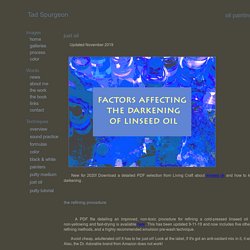
The De Mayerne manuscript (1620 --1632) is full of recipes for fixing linseed oil so it won't yellow as much: this was obviously an issue with the oil that was still often preferred for its strength and quicker drying. This, in addition to the color of the oil I saw oozing out of tubes of commercial paint, even very high quality commercial paint, always made me nervous about using commercial, "alkali-refined" linseed oil. I didn't doubt that linseed oil could be used in a non-yellowing manner: this was clear from older paintings and the analyzes by the National Gallery in their yearly Technical Bulletins. In fact, commercial linseed oil has gotten better over the last few decades; several manufacturers now sell a linseed oil which, while ultra-refined, doesn't yellow that much.
It could be used, for example, in high value, lower chroma colour schemes without issue. The Secret to Oil Painting Without Solvents. Method #6 D.I.Y.
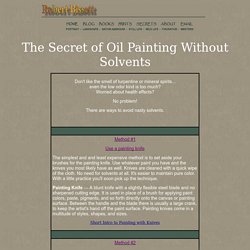
Medium Calcite Sun Oil...with regular oil paint Buy the book and make it at home. 1. Solvent-Free Oil Painting. There is nothing more natural and enduring than oil painting.
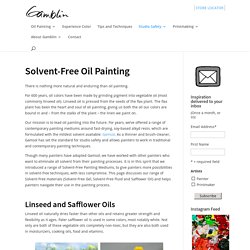
Egg Tempera. I originally wrote this for the Niagara Calligraphy Guild Newsletter Egg Tempera is a painting medium and method, but painters sometimes have to put calligraphy and calligraphic ornaments in their pictures.
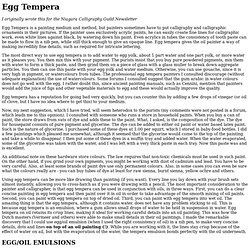
If the painter uses exclusively acrylic paints, he can easily create fine lines for calligraphic work, even white lines against black, by watering down his paint. Even acrylics in tubes the consistency of tooth paste can be made to flow in a nib pen, while still thick enough to give an opaque line. Egg tempera gives the oil painter a way of making incredibly fine details, such as required for intricate lettering. The most direct way to use egg tempera is to add water to egg yolk, about 1 part water and one part yolk, or more water as it pleases you. Egg tempera has a reputation for going bad very quickly, but you can counter this by adding a few drops of vinegar (or oil of clove, but I have no idea where to get this) to your medium. Nosolvents. M.

Graham & Co. offers artists a safer non-toxic and environmentally conscious method for traditional oil painting you won't find with any other brand of artists color! (Winsor & Newton, Grumbacher, Daler-Rowney, Rembrandt, DaVinci...the list goes on and on!). Cleaning To avoid solvents while cleaning, use Walnut oil in place of turpentine or odorless mineral spirits. Walnut oil removes color from the artist's brush, palette or hands as effectively as odorless paint thinners without creating a hazard to the individual or the environment.
To clean brushes while painting, keep two small jars (one "dirty"-one "clean") filled with Walnut Oil-a small piece of screening can be kept in the jar bottom to facilitate removal of color from the brush. Since Walnut Oil is slow drying, the same method can be used at the end of the day. Technique -Paint Thinly...Heavy applications of color are too massive (ultimately brittle) to age well. History.